Email automation management refers to the process of how you setup, manage, and update your automated email campaigns.
It’s important that you manage your email automation effectively:
Triggered emails get 70% higher open rates and 152% higher CTRs than drip emails
Relevant emails drive 18X more revenue than broadcast emails
Only 51% of companies are currently implementing marketing automation of any kind (meaning there’s a good chance you can do better than your competition)
Best Process For Email Automation Management
Email automation management should be as agile as possible. You shouldn’t strategise a big campaign and set up a complicated behemoth of email automation before first testing your results.
Instead, think like a SaaS developer, who would build one small feature at a time, frontend then backend (while working as agile as possible).
By the same token, you should strategise how to solve for one problem at a time, or a few related problems. This is in contrast to strategising a complex, robust email campaign that covers every possible use case.
You’ll have better results if you take one problem, figure out how to fix it, trigger that message, and then measure response than if you setup dozens and dozens of emails for different purposes all at once.
Here’s the email automation management process we recommend you follow:
Strategy: Start with a problem and discover what you can do to solve it, such as a high rate of new subscribers not logging in after they start their free trial.
Setup: Next, choose the correct Smart Group (or apply customer filters) to target the right people to receive this message, based on a specific action or even a lack of engagement.
Write the copy: Then it’s time to craft a message that appeals to this group of customers or prospects, based on the targeting criteria and where they’re at in the customer journey.
Updates & optimisations: Email automation management also includes the process of reviewing, updating, and optimising your emails to ensure that they’re effective and up-to-date.
Let’s take a look at all of these steps and stages in more detail.
1. Start with strategy
Clichés exist for a reason right? Right.
Starting with strategy might be a cliché, but you have to start with strategy if you want to you want to manage email automation in a way that’s truly effective and engages with the right customers at the right time.
We recommend that you start with a common problem or known problem. You can work together with your marketing, product, and/or digital teams to brainstorm some issues that email automation might be able to solve.
You can also take a look at these common issues and see if any apply to your business:
Not trying to save abandoned carts: If you’re an ecommerce company with no systems setup for saving abandoned carts, such as emails that remind shoppers over the course of three days, then that would be a great place to get started with email automation.
Not getting feedback on cart abandonment: Why do customers abandon your checkout? You could send an email asking for their feedback to find out if its something wrong with the product, or with your checkout experience.
Free trial churn for SaaS: You don’t want to bombard active free trial users with the wrong kinds of messages, however for users who haven’t logged in in the last couple of days, sending them helpful messages is a must.
Churn for digital publishers and content subscriptions: As a digital publisher offering a paid content subscription, if readers haven’t visited your site in 7 days, that could be a sign of churn. Catch them before it’s too late with an email sharing your best recent headlines.
Not engaging leads that are close to purchasing (B2B): With higher priced B2B offers, it’s essential to engage leads that are showing interest in your product or service. Maybe they’re downloading a white paper or viewing your pricing page. You can send a timely email to ask if they have questions or offer to schedule a time for a demo.
If you’re not quite sure where to start with email automation, and you’re not aware of any problems that could be solved with email, then you can start by taking a look at different customer filters and see if that sparks any ideas.
Here are just a few of the top customer/prospect filters:
Downloaded a white paper
Downloaded a white paper X times
Last seen on site X days ago
Recently purchased
Viewed pricing page
Viewed blog
Abandoned cart
There are dozens and dozens of different customer and website user filters to choose from. EcoSend includes a customer data hub so you can understand who are your most loyal customers and users, who’s about to buy, and who’s at risk of churning.
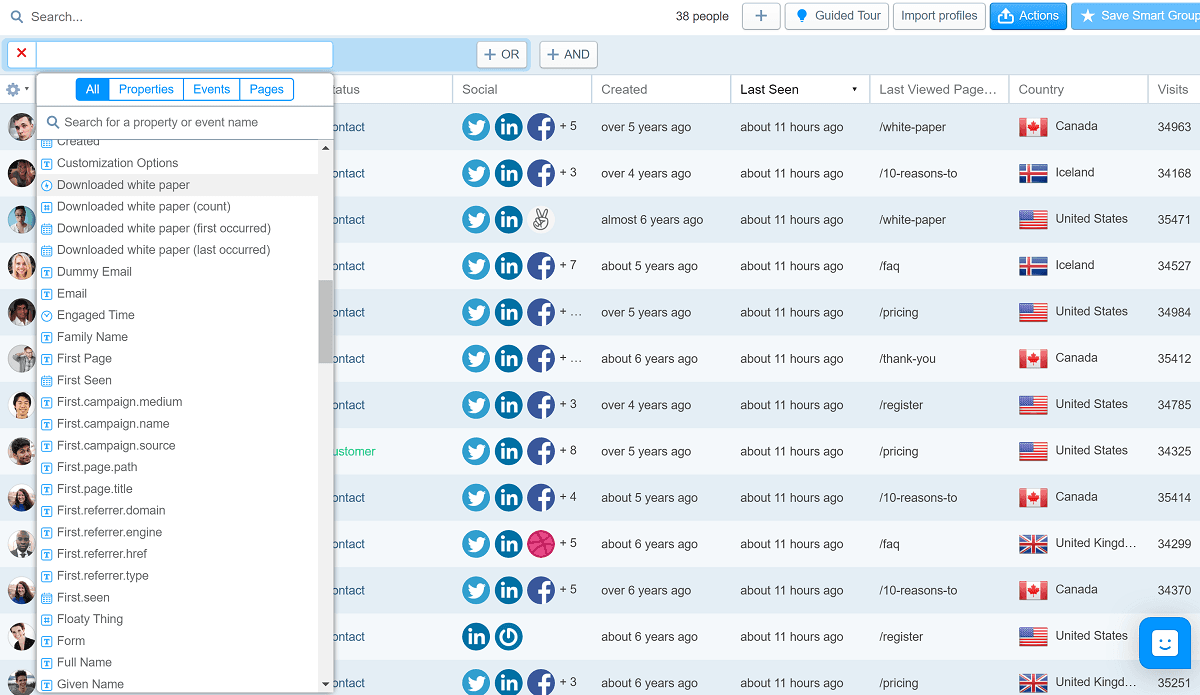
You can check out those customer filters inside of the Customer Data Hub to view the people that match that criteria.
You can also setup email automation for these different customer filters as well. You can combine customer filters to create your own Smart Group or choose from some pre-existing Smart Group criteria.
When you create a new automated message, you can choose from these different filters:

Here are some additional filters you can choose from when triggering an automated email:
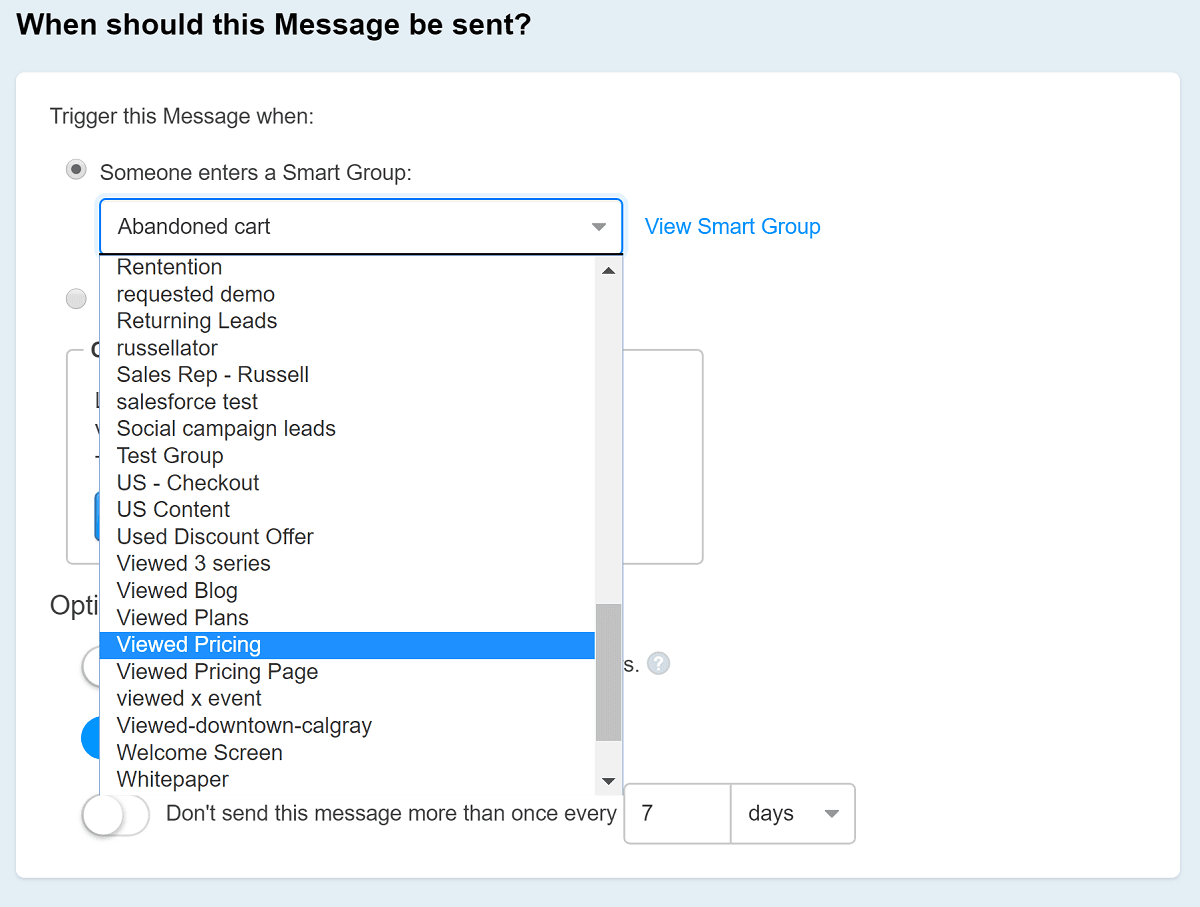
While it’s best to start with some known issues you’re experiencing with website visitors and customers, you can also use the above drop down lists for inspiration.
2. Email Automation Management Setup
Once you know what group of customers you want to target in your email, setting up the messages is fairly simple.
There are a few things you need to be aware of:
Give your automated email message a descriptive title. Make sure it’s clear, so when you get to the ongoing review stage, you’ll remember what this email is for.
Select the relevant Smart Group (customer filter criteria). For most messages, you’ll select entering the Smart Group as the trigger, but leaving a Smart Group could also be a trigger. For example, let’s say you have a Smart Group of people who have visited your website in the last 10 days. When someone leaves that Smart Group, they might be at risk of churning, and need to receive a re-engagement email.
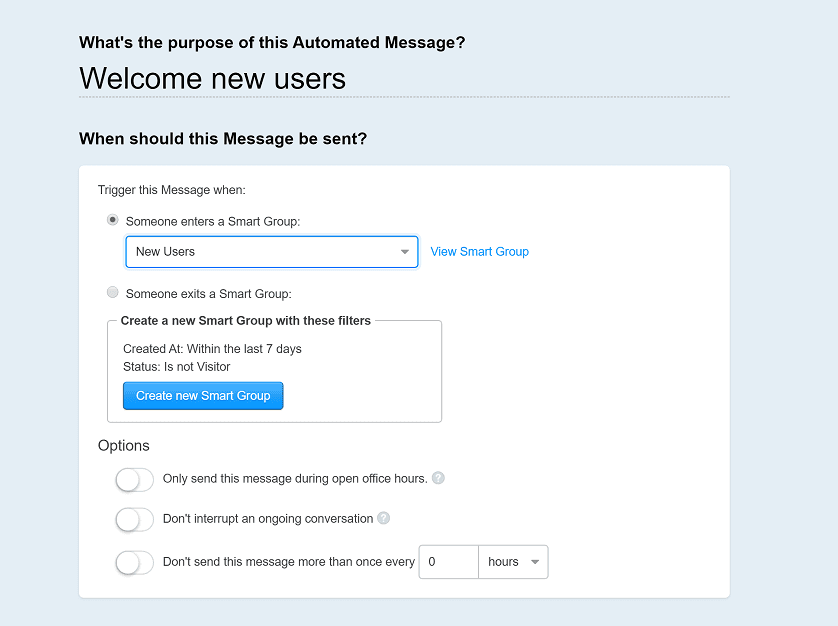
Selecting the Smart Group is the most important thing when setting up your messages.
But there are other options to be aware of too.
You can choose to send the message during your business’s office hours, so that if you use the email to invite someone to chat with your team on your website, you make sure someone is actually there! You can also utilise this setting to make the email timing a bit more natural. This is great for B2B companies, but probably not needed for ecommerce sites.
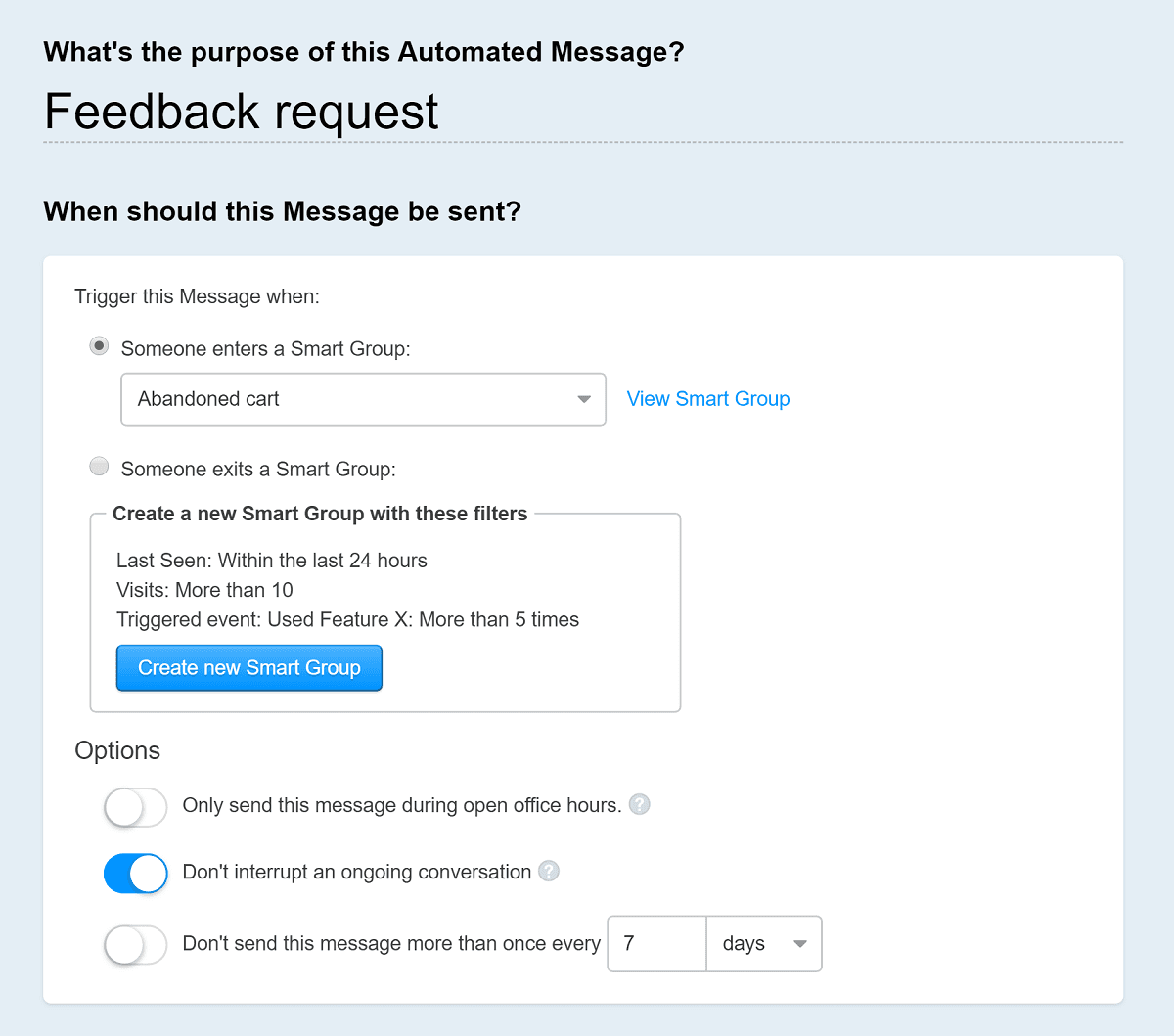
You can also make sure that messages are not repeated too often. You can set messages to not repeat in intervals of hours, days, or months. This is important if customers or website visitors could possibly enter and exit a Smart Group frequently.
For example, you might count viewing your blog as a form of engagement and want to send a prospect follow up content when they view your blog. But you wouldn’t want to do this daily, or possibly even weekly, depending on your business.
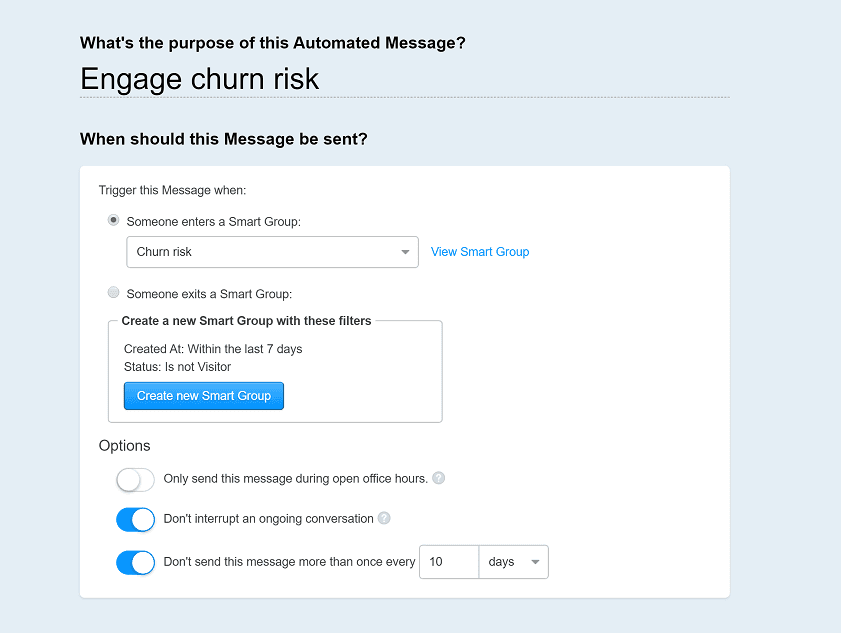
3. Email Automation Copywriting
The next step in email automation management is writing the copy.
Often times, the software and setup is the simplest part, but knowing what to say is hard. The very best thing you can do is to look at examples to spark your creativity. Even professional copywriters do this. They can them “swipe files” and they save different emails so that they can later templatize them and follow a similar structure or style.
Each of those posts has plenty of real life examples.
Inside of EcoSend, you can craft your automated emails super easily.
Here’s what you’ll need to include:
The sender
The style (CTA button to any webpage or an invitation to chat)
Email subject
Message
Button text and link (for CTA-button emails)
What you write in the email comes down to what action you want the reader to take. Email management automation is all about efficiency. What do you want users to take action on, and how can you automate that request?
For invitation-to-chat emails, you can keep the content pretty simple. Here’s an example:
Hi there! I noticed that you didn’t complete your order. Do you have any questions for us? We’re available right now to answer your questions via chat.
For CTA-button emails though, what you say depends on where the button link is sending traffic. You might use that button to send users to:
Your homepage
The page on your site that they viewed recently which triggered you to send the email (such as viewing your pricing page or contact form)
The shopping cart
A recent blog post
Another piece of content that relates to a whitepaper they just downloaded
When you know what you want readers to click on, then the entire point of that email becomes getting as many people as possible to click on that button.
Use teaser bullet points to show what they might learn in a new blog post, include testimonials that will make them want to dive back into your pricing page, or remind them of the benefits of the product that they had added to their cart.
4. Updates & Optimisations: Ongoing Email Automation Management
Email automation management is an ongoing task.
Review your emails at the end of every month. (Do it sooner if you’re launching a lot of different email campaigns based on previous performance).
Look for number of sends: if the number seems lower than you expected, consider changing the Smart Group to be just a little more broad, or removing one criteria. For example, you might switch from downloading 2 white papers to downloading just 1 for the email criteria.

You might also want to add different emails for different criteria every month as well.
Too many companies fail at email automation management because they turn it into one big project. When you break it down into individual emails that solve problems and target different customer groups, it becomes simpler.
Plan on reviewing, editing, and adding emails monthly.
Email automation management is still an underutilised digital strategy. It can help win back customers, close deals, and increase LTV.
Need a tool for the job? Start your free trial of EcoSend today!




